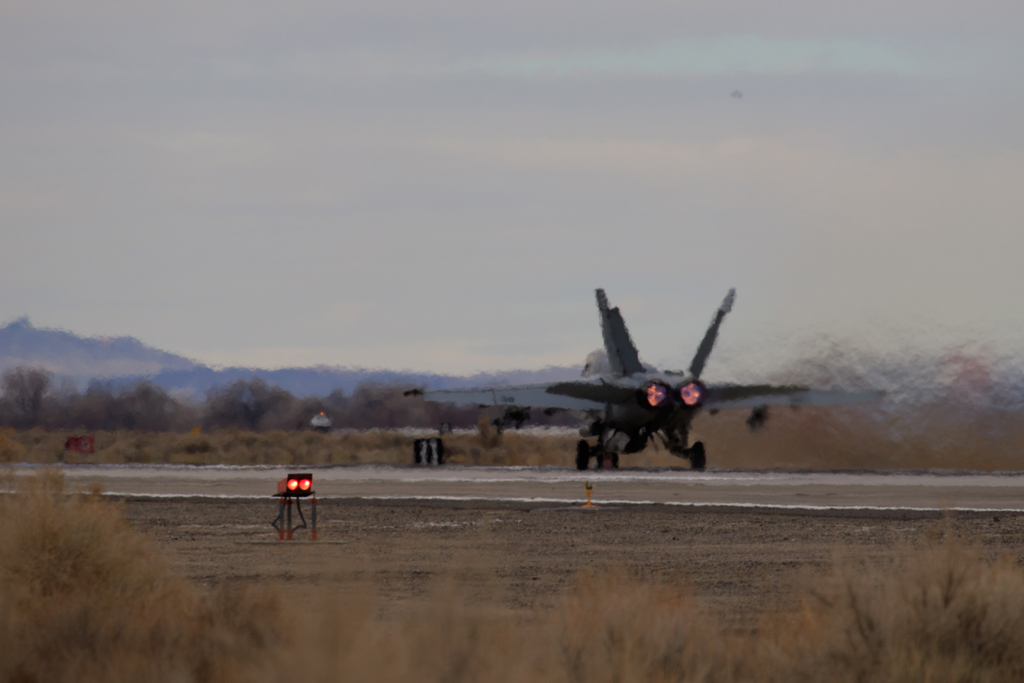Fallon has been called by some (the late George Hall mainly, in its Superbase books series) the “supercarrier in the desert”, and with reason: it hosts in numbers all the aircraft types the Navy usually operates from its aircraft carriers. In fact, it is the center of excellence for naval aviation training and tactics development.
The mission of this airbase, located in western Nevada near Reno, is focused on advanced training and its main command Naval Aviation Warfighting Development Center (NAWDC, pronounced NAW-DIK) is two-fold: host the carrier air wings (CVWs, also called CAGs – carrier air groups) during their work-ups before deployment, and teach advanced combat warfare to selected pilots. This last mission is the heritage of several well-known courses including “Topgun” and “Strike U”. Nowadays, these two courses are unified into a 13 weeks long Topgun course.

Topgun made example for other flying communities who too created graduate level schools : Top Dome for E-2 controllers, Seawolf for Seahawk helicopter pilots and HAVOC for EA-18G Growler EW crews.



At Fallon, the tarmac is divided into two areas: the south ramp is dedicated to NAWDC aircraft as well as VFC-13 F-5Ns, and the north ramp hosts Carrier Air wings for their work ups, and aircraft from the fleet when their crews come here for Top Gun or HAVOC. NAWDC operates legacy F/A-18 Hornets (“charlie” models) as well as Super Hornets (“echoes” and “foxtrots”), EA-18G Growlers, E-2C hawkeyes and F-16A and Bs.


During our visit, “CAG-5” should have been in the middle of a work-up before a cruise. But as it is a permanently deployed Carrier Air Wing in Japan, only two of its squadrons came to Fallon for the readiness program before the at-sea period : VFA-27 “Royal Maces” (NF-2xx) and VFA-102 “Diamondbacks” (NF-1xx). This program is called SFARP (for Strike Fighter Advanced Readiness Program) and is intended to maximize the tactical proficiency of strike fighter aircrews across the full spectrum of F/A-18 mission sets by using academic lectures, simulator events, and tactical training sorties. After a local training and initial syllabus at their homebase NAF Atsugi in Japan, given by Strike Fighter Tactics Instructor (Topgun graduates), the squadrons shifted to NAS Fallon, flying their aircraft across the Pacific to take advantage of the unique training opportunities offered by the Fallon Range Training Complex (FRTC).
When such squadrons or full airwings come to Fallon, they come en masse with their full complement of sailors for maintenance. This is also a way of training them for surge operations in a deployed configuration. On the opposite, NAWDC aircraft on the south ramp are all taken care of by a team of private contractors.


Both squadrons, VFA-27 and VFA-102, moved permanently from NAF Atsugi to MCAS Iwakuni a few days after our visit to Fallon.

Next to the CAG-5 birds, Fallon hosted an array of visitors from various squadrons of both Atlantic and Pacific fleets. Hornets and Super Hornets ware there for the Topgun course which lasts now 13 weeks, compared to 5 weeks in the 80’s, and 9 weeks in the 2000’s after it was mixed with “Strike U” at Fallon.
This course is made of several blocks, first “ground school”, then air-to-air, BFM and ACM, and air-to-ground, and in the end, advanced strike package tactics.

Aircrews participating to Topgun course during our visit, and seen on the came from the following squadrons :
VFA-154 Black Knights CVW-11 USS Nimitz (NH-1xx )
VMFA-323 Death Rattlers CVW-11 Nimitz (WS-4xx or NH-4xx )
VFA-143 Pukin Dogs CVW-7 USS Lincoln (AG-1xx )
VFA-83 Rampagers CVW-7 USS Lincoln (AG-3xx )
VFA-25 Fist of the Fleet CVW-7 USS Lincoln (AG-4xx )
VFA-81 Sunliners CVW-17 USS Roosevelt (NA-2xx )
VFA-87 Golden Warriors CVW-8 USS Bush (AJ-3xx)


The adversary component was provided by the local VFC-13 Fighting Saints and their F-5N Tigers II (ex-Swiss Tigers), and by the dedicated reserve adversary squadron from NAS New Orleans, the VFA-204 River Rattlers, with their F/A-18Cs (modex AF-4xx).
The Saints fly colorful Tigers and their “Rotten Banana” and “Mig28” schemes are particularly attractive for the aviation photographer. When it comes to air-to-air combat, their pilots know how to take full advantage of their nimble and small metal bird; the Tiger is particularly difficult to see head-on and young fleet pilots learn this the hard way.





After an hour spent on the NAWDC ramp, we were able to get some time near the runway and the EOR (End of Runway) area. These moments were quite unique in the lifetime of a military jets enthusiast and aviation photographer as you cannot get closer from the action beside being in the cockpit. The author of this article can attest that earplugs were more than needed, as he forgot to put them on while 3 Super Hornets took off in sequence, rattling the air and every piece of the body, drilling the inside ear for a long 40 seconds. Never a louder noise has been heard.





For more than one hour, it was an uninterrupted ballet of take offs and landings on both parallel runways. The weather was deteriorating and a flight of 4 F/A-18Fs was forced to abort their mission at the EOR and taxi back to the ramp.

This visit was a great opportunity to witness the efforts the US Navy puts into training its aircrews and keeping them at their best level throughout their operational career.

The author wishes to thank the Navy Public Affairs Office at NAS Fallon, and Mr Zip Upham in particular.









